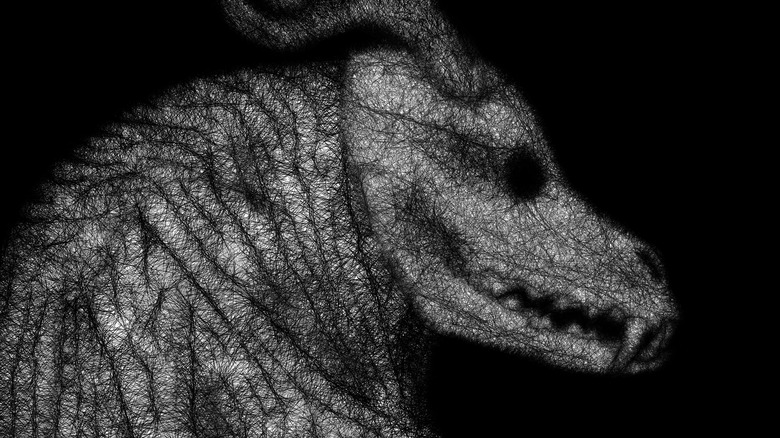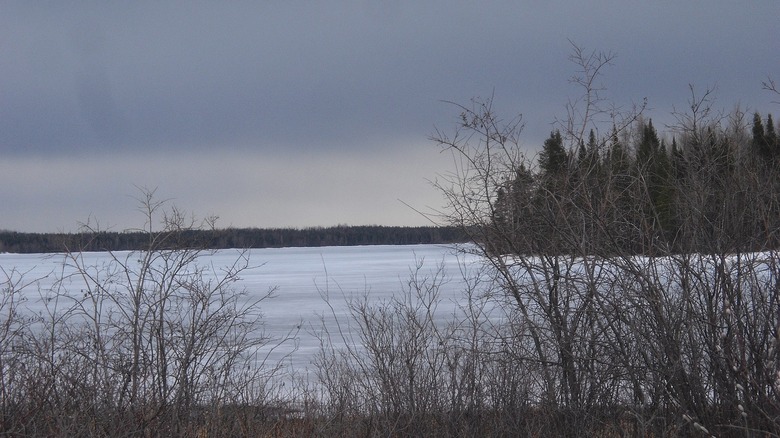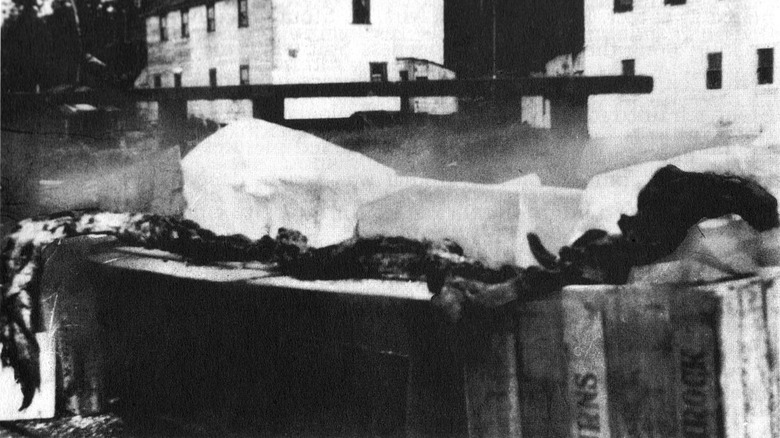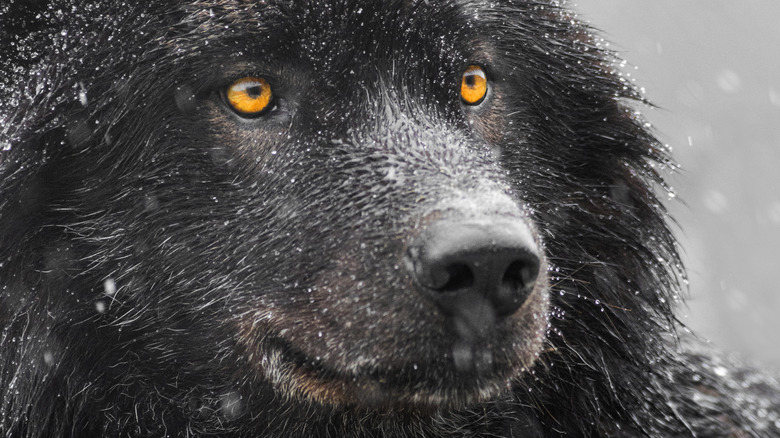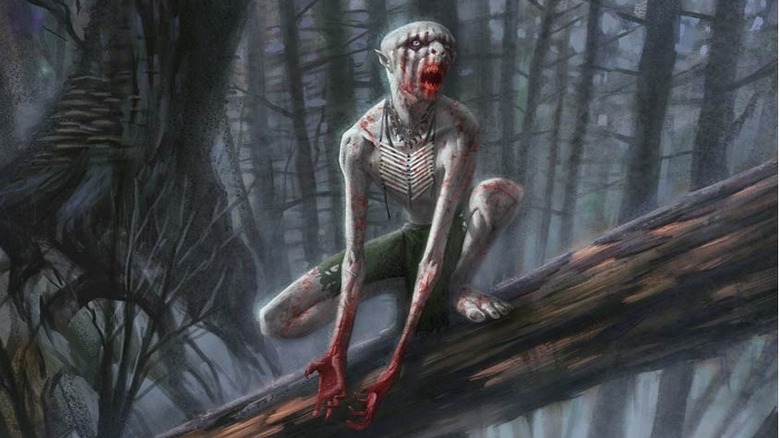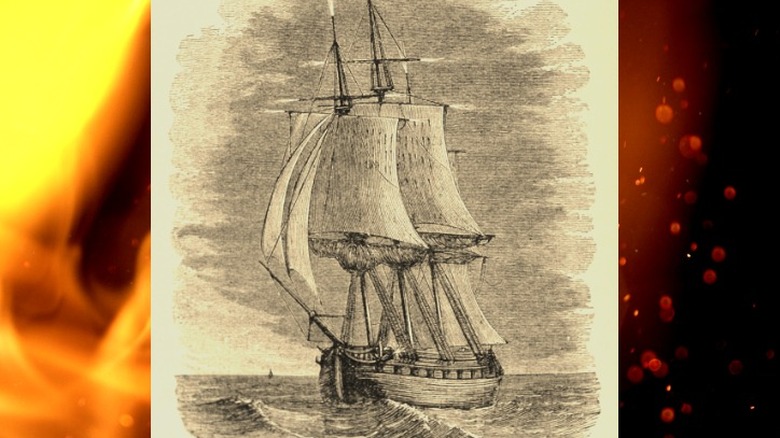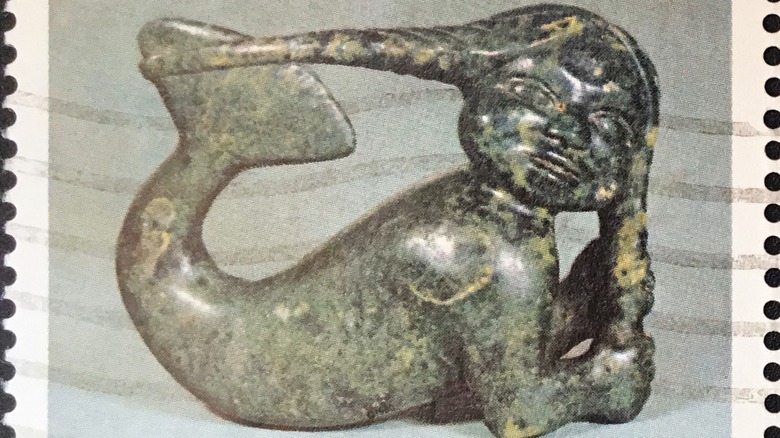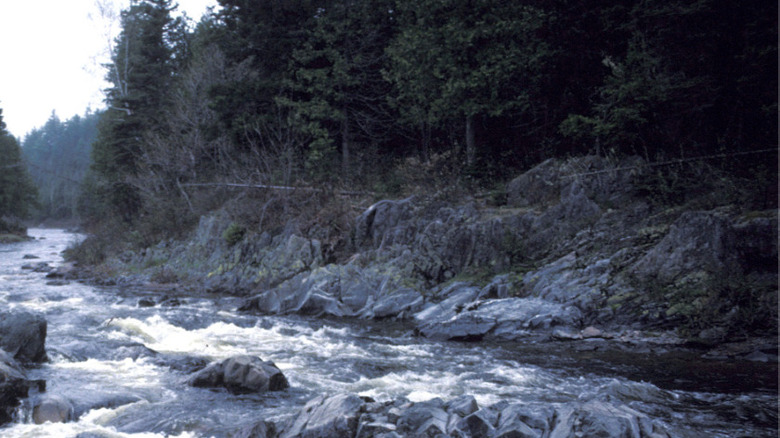Creepy Myths From Canada That'll Keep You Up At Night
Canada has a rich tradition of folklore, so there's no shortage of legends about ghosts, monsters, and death omens. As described by the Canadian Encyclopedia, the country's abundance of languages and cultures has led to a variety of fascinating oral traditions that exist side by side, as well as building on each other in unexpected ways.
Some of these chilling tales, like stories about the werewolf-like rougarou (via the Métis Museum), show the way that myths from one Canadian culture have blended with another. Others, like the legend of the beloved lake monster Ogopogo, have shifted and changed from their original meaning (per BBC). Some terrifying Canadian folk stories have become pop culture sensations, while others are still rarely told outside of the cultural community they're a part of. New urban legends are always originating in Canada, but these are the centuries-old tales that still keep people awake at night.
Omajinaakoos
In 2010, two women were walking with their dog near an Oji-Cree community in Northwestern Ontario known as Kitchenuhmaykoosib Inninuwug, or Big Trout Lake. Their dog discovered the carcass of a strange animal in a local creek. Some in the Big Trout Lake community believe the strange remains are actually an omajinaakoos or the "ugly one," which is a sign of impending disaster, according to CTV News.
There are occasional accounts of people from Big Trout Lake seeing an omajinaakoos, going back decades. Typically, it is described as living in swampy areas and eating beavers. The creature is supposed to be evasive, but when it is seen, it's a bad omen for the future.
As described by The Globe and Mail, the two women who discovered the animal's carcass were unable to find it again later, and it is speculated that it could've been washed back into the creek or eaten by scavengers. The photos that were taken have been analyzed by experts and enthusiasts alike. As detailed in National Post, some suspect the remains were actually a mink that decomposed in a particularly unsettling way in the water.
Whatever the foot-long "Big Trout Lake monster" pulled from the creekbed actually was, it led to a flurry of interest in stories about the elusive swamp-dweller omajinaakoos.
Nakani the Wildman
In the early 1900s, at least two prospectors traveled to the Nahanni Valley in Northern Canada in search of gold. Their bodies were found headless and mutilated. Another prospector's cabin was found burned and his head, too, was missing. As recently as 1945, a man's body was found in the region, decapitated. The mystery of who, or what, killed these men remains unsolved, but as described by The Outdoor Journal, the story has captivated people for over a hundred years.
Around 1950, Philip Godsell wrote that he had been told by the indigenous people that there was a group of terrifying creatures called "Nakanies" living in the caves. As quoted by author Hammerson Peters, Godsell stated that the Nakani had been described to him as being twice as large as a person, and sometimes capturing those who entered their territory. Some have attributed the deaths of the prospectors in Nahanni Valley to the Nakani.
Much is still unknown about the legend of the Nakani wildmen. As noted by professor and historian Shawn Smallman, the available accounts about the Nakani legend from this era were written down by white missionaries and explorers, rather than by the people from whom the legends originated, so it is difficult to know how accurate they were to the original folklore. In April 2020, a documentary team reported that they had been in contact with Dene elders to record first-hand accounts of their local legends.
Caddy, sünuƚqaz, and other serpents
One of Canada's popular cryptids is a sea serpent, reportedly spotted near British Columbia, known as Cadborosaurus, or "Caddy." As stated by Scientific American, those who claim to have seen the creature describe it as a massive snake with a horse-like face and sometimes antlers. Experts have found that instead of a small sea monster lurking in the water, witnesses may have actually seen pipefish, seals, or swimming deer, but some people continue to believe in the beast.
Caddy is far from the only snake-like creature in Canadian folklore. As described in an Anthropological Linguistics article by Jan P. Van Eijk, one of these legends was extremely pervasive in Salish culture. Sometimes called sünuƚqaz, it is described as a powerful spirit that appears as an enormous snake. One variation is described as living deep at the bottom of lakes, controlling all the lizards and herons that live there. Those seeking the creature were advised never to turn their backs when trying to leave its lair, or their entire body would twist and break, killing them instantly.
Looking at these supernatural snakes is not always the safest option, however. The Ts'elxwéyeqw people, also known by the English name "Chilliwack," have a legend about a frightening snake. As described in "The Chilliwacks and their neighbors," some believed there was a two-headed snake that lived in the swamps, and those misfortunate enough to catch a glimpse of it would vomit.
Charlottetown bell-ringers
In 1853, a small church on Prince Edward Island became the site of one of Canada's most beloved ghost stories. As described by Edward MacDonald of the University of Prince Edward Island, the sound of a ship's bell coming from a church tower eventually became known as an omen of the deadly disaster that was to come.
In the 1850s, there was an old steamship called the Fairy Queen that sailed around the area every few days delivering mail and carrying passengers. One windy day in early October, the crew accidentally allowed the fires in the boiler to go out. Unfortunately, the old ship leaked, and required pumps to keep it from filling with water. The crew was forced to abandon the ship, but a cabin boy and several passengers were left onboard when it sank. Seven were killed, four of them members of a congregation in the Charlottetown church Kirk of St. James.
According to the legend, two people at the church in Charlottetown heard a ship's bell ringing from the bell tower of the church. As they approached to see what was making the sound, they saw three women dressed all in white going into the church to join a fourth in the bell tower. When the two men reached the top of the bell tower, there was no one there.
Rougarou
Like most folklore, the story of the rougarou changes from community to community, but all versions are terrifying. As described in the Toronto Star, it originates with the Métis people, who have shared legends about the creature known as the rougarou for at least a century.
As described by the Métis Museum, the rougarou is a werewolf-like creature that may appear as a wolf, dog, horse, or half-human half-horse hybrid. According to some versions of the story, the rougarou is created if a person runs afoul of the Creator, whereafter they may become possessed. Some versions of the legend say the only way to stop the creature is to strike it between the eyes with a skeleton key, transforming it back into a human being — but if you tell anyone else the name of the person who had previously been possessed, you become the next rougarou.
Rougarou stories share some elements with stories of the French-Canadian "loup-garou," which is a similar werewolf-like creature dating back to 16th century France. As described by Atlas Obscura, the stories have traveled South. In Cajun culture, there are stories about the rougarou stalking its prey in the Louisiana Bayou.
Ogopogo
Like Loch Ness, Okanagan Lake in British Columbia also has a feared and beloved lake monster: Ogopogo. As described by the BBC, those who claim to have seen the creature describe it as a massive black sea serpent with a sheep-like face that swims through the lake, frightening unsuspecting witnesses.
Since the 1920s, Ogopogo has been a source of tourism for the city of Kelowna, where the lake sits. While the idea of it may have inspired awe and terror in the past, its name comes from a popular folk song and the creature became a popular folk tale. In the 1980s, Ogopogo became a phenomenon, and there was even a $1 million reward offered for proof that the cryptid was a real animal. The legend is actually far older, however. A member of the Westbank First Nation explained to the BBC that they don't view Ogopogo as a monster or an endangered animal, but believe it is actually the spirit of the lake itself, which the native people call "n ̓x̌ax̌aitkʷ," pronounced, "n-ha-ha-it-koo."
The Syilx people traditionally make offerings to n ̓x̌ax̌aitkʷ, the spirit of the lake, thanking it for providing for them. Some in the community believe the story about Ogopogo being a monster came from early Christian missionaries misinterpreting this ritual, and the settlers who colonized the area came to believe there was a monster in the lake.
Wendigo
Stories about the wendigo have become incredibly popular in recent years. As described by Atlas Obscura, there are multiple versions of the legends about the wendigo, each equally horrifying. Modern depictions of wendigos in horror movies tend to show them as tall monsters with deer-like skulls creeping around the Canadian wilderness. Older legends are different, depicting the wendigo as a human-like giant with a frostbitten face, constantly hungry for flesh.
The original stories come from the spiritual beliefs of the Algonquin people from areas near the Great Lakes and St. Lawrence River. As described by Brady DeSanti, a professor of Native American Studies at the University of Nebraska at Omaha, in an interview with Backstory, traditional wendigo legends describe a very human-looking creature who slowly grows over time, until it is a giant. Some versions of the story describe the unfortunate creature as being so hungry it eats its own lips.
Its uncontrollable and destructive hunger sometimes represents greed. Sometimes, the wendigo is depicted as having once been an ordinary person who was transformed because of a curse or as punishment for some heinous act, like cannibalism. As chilling as these stories are, Grace Dillon, professor of Indigenous Nations Studies at Portland State University, told Backstory that many wendigo myths have hopeful endings.
Flaming ghost ship
Since Prince Edward Island is sometimes surrounded by stormy seas, it's unsurprising that one of its most popular urban legends is about a ship. This apparition is described as an old-fashioned schooner being engulfed in flames. As described by NUVO, there have been reports of people seeing the ghost ship in the 21st century, but the myth dates back to 1786.
For hundreds of years, there have been occasional sightings of this burning vessel. Some are more detailed than others. In 1900, sailors claimed they had seen crew members from the doomed craft trying to escape the blaze in a rowboat, only for the boat and the men aboard to vanish.
Since the 20th century, skeptics have been looking for an explanation for these bizarre sightings. Some have suggested it may be a mirage or the moon over the horizon. Some have suggested it may be Saint Elmo's fire, a strange light from atmospheric electricity that can appear on the masts of ships in storms, according to Britannica.
Dogmen
The story of the woman who married a dog is a very popular traditional Inuit legend in Canada and Greenland. In some versions of the legend, like a retelling published by The Journal of American Folklore, the girl does not want to get married and rejects all of her suitors, prompting her father to threaten a forced marriage with a dog. Instead of relenting, the girl calls his bluff and chooses one of his dogs to be her husband.
In another version, as described in The Native Directory, the dog is a shapeshifter. In this version, the family welcomes a handsome stranger wearing a necklace of dog teeth into their igloo during a terrible storm. In the morning, the man has vanished. The girl's father suspects that one of his own dogs was able to disguise himself as a man. Soon after it is discovered that the girl is pregnant, and when her father realizes she must have been impregnated by their mysterious visitor, he abandons her on a remote island before she can give birth. However, the dog swims to the island and brings her food. Half of her children are born with suspiciously dog-like characteristics.
Cabbagetown tunnel monsters
In 1979, a reporter named Lorrie Goldstein interviewed a man from Cabbagetown, a neighborhood in the city of Toronto, about a strange experience he'd had while looking for a lost kitten the year before. In the interview with The Sun (via the Torontoist) the man identified only as Ernest stated that when a kitten he was caring for escaped, he decided to search for it inside a cave. Inside, he claimed to have seen a monster.
Ernest claimed the creature was about three feet tall, gray, and ape-like, with orange-red eyes. Most astonishingly, he also claimed that the creature spoke to him, telling him to 'Go away.' Ernest believed the cave was connected to the sewer tunnels under the city, though this has been debated.
As reported by the Torontoist in 2013, there have been no further reported sightings of gray monkey men living in the Toronto sewers since Ernest gave his testimony in 1979, but that hasn't stopped conspiracy theorists from speculating about what might be lurking in the tunnels under the city.
Old Hag
A person is fast asleep when suddenly they awake to find they can't move. It feels like something is holding them down, and if they don't escape soon, they will die. As detailed in the first section of The Terror that Comes in the Night, which focuses on accounts from Newfoundland, this is a phenomenon known by many in the region. Their explanation: the Old Hag.
As stated by Nuvo, the Old Hag is supposed to look like a long-haired old woman. Many have described the experience of waking up in the night to find her standing in their bedroom doorway, beside the bed, or even sitting on top of them, crushing their chest. Some versions of the myth advise summoning the Hag on purpose by saying the Lord's Prayer backward and ambushing her by having something sharp positioned on the sleeper's chest to stab the Old Hag when she climbs on top of them.
There is a possible explanation for these harrowing experiences: sleep paralysis. As stated by the NHS, when a person experiences sleep paralysis, they are awake but unable to move. People with sleep paralysis often feel like they are being crushed, experience feelings of terror and dread, and sometimes feel as though there is someone or something else in the room.
Dungarvon Whooper
There are many versions of New Brunswick's most beloved ghost story, but all of them center on a mysterious sound in the night. Sometimes the source is an ordinary human, sometimes it's an enormous creature like a wildcat, and sometimes it is the restless spirit of a murdered man.
As described by The University of Maine, the story dates back to the 19th century. According to one popular version of the legend, a man from a local lumber camp was found dead by his friends and buried along the Dungarvon River. That night, they were tormented by a mysterious wailing or whooping sound. In another version, the midnight howls were heard after a man was killed in a logging accident (possibly as punishment for having said something blasphemous).
The legend was further popularized by a folk song recorded by Billy Price. In this version, the heroes of the story are forced to fight the Dungarvon Whooper, which takes the form of a large animal, likely a puma.
